MICS/ISM Meander-Line Microstrip Antenna Encapsulated in Oblong-Shaped Pod for Gastrointestinal Tract Diagnosis
Abstract
1. Introduction
2. Camera Pod Scheme and Antenna Structure
3. Results and Discussion
3.1. Simulation Results
3.2. Experimental Results
4. Conclusions
Author Contributions
Funding
Institutional Review Board Statement
Informed Consent Statement
Data Availability Statement
Conflicts of Interest
References
- Rosen, A.; Rosen, H.D. The role of engineering principles in the medical utilization of electromagnetic energies from kHz to visible light—Examples. J. Infrared Millim. Terahertz Waves 2009, 30, 1347–1386. [Google Scholar] [CrossRef]
- Rosen, A.; Stuchly, M.A.; Vorst, A.V. Applications of RF/microwaves in medicine. IEEE Trans. Microw. Theory Tech. 2002, 50, 963–974. [Google Scholar] [CrossRef]
- Ishida, T.; Inoue, T.; Inoue, T.; Endo, T.; Fujimura, M.; Niizuma, K.; Endo, H.; Tominaga, T. Brain temperature measured by magnetic resonance spectroscopy to predict clinical outcome in patients with infarction. Sensors 2021, 21, 490. [Google Scholar] [CrossRef] [PubMed]
- Lee, Y.Y.B.; Huang, Y.; El-Deredy, W.; Lisboa, P.J.G.; Arus, C.; Harris, P. Robust methodology for the discrimination of brain tumours from in-vivo magnetic resonance spectra. IEE Proc. Sci. Meas. Technol. 2000, 147, 309–314. [Google Scholar] [CrossRef]
- Nelson, B.D.; Karipott, S.S.; Wang, Y.; Ong, K.G. Wireless technologies for implantable devices. Sensors 2020, 20, 4604. [Google Scholar] [CrossRef] [PubMed]
- Mahfouz, M.R.; To, G.; Kuhn, M.J. Smart instruments: Wireless technology invades the operating room. In Proceedings of the IEEE Topical Conference on Biomedical Wireless Technologies, Networks, and Sensing Systems (BioWireleSS), Santa Clara, CA, USA, 15–18 January 2012; pp. 33–36. [Google Scholar]
- Islama, M.N.; Yuce, M.R. Review of Medical Implant Communication System (MICS) band and network. ICT Express 2016, 2, 188–194. [Google Scholar] [CrossRef]
- Shobha, G.; Chittal, R.R.; Kumar, K. Medical applications of wireless networks. In Proceedings of the Second International Conference on Systems and Networks Communications (ICSNC 2007), Cap Esterel, France, 25–31 August 2007; pp. 1–6. [Google Scholar]
- Ghamari, M.; Janko, B.; Sherratt, R.S.; Harwin, W.; Piechockic, R.; Soltanpur, C. A survey on wireless body area networks for eHealthcare systems in residential environments. Sensors 2016, 16, 831. [Google Scholar] [CrossRef] [PubMed]
- Damaj, A.; el Misilmani, H.M.; Chahine, S.A. Implantable antennas for biomedical applications: An overview on alternative antenna design methods and challenges. In Proceedings of the International Conference on High Performance Computing & Simulation (HPCS), Orleans, France, 16–20 July 2018; pp. 31–37. [Google Scholar]
- Abadia, J.; Merli, F.; Zurcher, J.-F.; Mosig, J.R.; Skriverviki, A.K. 3D-spiral small antenna design and realization for biomedical telemetry in the MICS band. Radioengineering 2009, 18, 359–367. [Google Scholar]
- Scarpello, M.L.; Kurup, D.; Rogier, H.; Ginste, D.V.; Axisa, F.; Vanfleteren, J.; Joseph, W.; Martens, L.; Vermeeren, G. Design of an implantable slot dipole conformal flexible antenna for biomedical applications. IEEE Trans. Antennas Propag. 2011, 59, 3556–3564. [Google Scholar] [CrossRef]
- Lee, C.-M.; Yo, T.-C.; Huang, F.-J.; Luo, C.-H. Bandwidth enhancement of planar inverted-F antenna for implantable biotelemetry. Microw. Opt. Technol. Lett. 2009, 51, 749–752. [Google Scholar] [CrossRef]
- Lee, C.-M.; Yo, T.-C.; Luo, C.-H.; Tu, C.-H.; Juang, Y.-Z. Compact broadband stacked implantable antenna for biotelemetry with medical devices. Electron. Lett. 2007, 43, 660–662. [Google Scholar] [CrossRef]
- Kumar, S.A.; Shanmuganantham, T. Implantable CPW fed dual folded dipole antenna for biomedical applications. In Proceedings of the International Conference on Computing, Communication and Networking Technologies, Coimbatore, India, 26–28 July 2012; pp. 1–5. [Google Scholar]
- Palandoken, M. Compact bioimplantable MICS and ISM band antenna design for wireless biotelemetry applications. Radioengineering 2017, 26, 917–923. [Google Scholar] [CrossRef]
- Farhad, G.; Mohan, A.S. Miniaturized slot PIFA antenna for tripleband implantable biomedical applications. In Proceedings of the IEEE MTT-S International Microwave Workshop Series on RF and Wireless Technologies for Biomedical and Healthcare Applications (IMWS-BIO), Singapore, 9–11 December 2013; pp. 1–3. [Google Scholar]
- Chrissoulidis, D.P.; Laheurte, J.-M. Radiation from an encapsulated hertz dipole implanted in a human torso model. IEEE Trans. Antennas Propag. 2016, 64, 4984–4992. [Google Scholar] [CrossRef]
- Nikolayev, D.; Zhadobov, M.; le Coq, L.; Karban, P.; Sauleau, R. Robust ultraminiature capsule antenna for ingestible and implantable applications. IEEE Trans. Antennas Propag. 2017, 65, 6107–6119. [Google Scholar] [CrossRef]
- Nikolayev, D. Modeling and characterization of in-body antennas. In Proceedings of the 2018 IEEE 17th International Conference on Mathematical Methods in Electromagnetic Theory (MMET), Kyiv, Ukraine, 2–5 July 2018; pp. 1–5. [Google Scholar]
- Fernández, M.; Thiel, D.V.; Arrinda, A.; Espinosa, H.G. An inward directed antenna for gastro-intestinal radio pill tracking at 2.45 GHz. Microw. Opt. Technol. Lett. 2018, 60, 1644–1649. [Google Scholar] [CrossRef]
- Wong, K.-L. Compact and Broadband Microstrip Antennas; John Wiley & Sons: Hoboken, NJ, USA, 2002. [Google Scholar]
- Lu, J.-H.; Yang, K.-P. Slot-coupled compact triangular microstrip antenna with lumped load. In Proceedings of the IEEE Antennas and Propagation Society International Symposium, Atlanta, GA, USA, 21–26 June 1998; pp. 916–919. [Google Scholar]
- Chen, H.-T. Compact circular microstrip antenna with embedded chip resistor and capacitor. In Proceedings of the IEEE Antennas and Propagation Society International Symposium, Atlanta, GA, USA, 21–26 June 1998; pp. 1356–1359. [Google Scholar]
- Wong, K.-L.; Chen, W.-S. Compact microstrip antenna with dual-frequency operation. Electron. Lett. 1997, 33, 646–647. [Google Scholar] [CrossRef]
- RO3210 TM Circuit Materials High Frequency Circuit Laminates; Rogers Corporation: Chandler, AZ, USA; Available online: www.rogerscorp.com (accessed on 20 August 2018).
- CST Studio Suite 3D EM Simulation and Analysis Software, Studio, C.P. CST Studio Suite; Simulia: Darmstadt, Germany, 2010.
- Italian National Research Council Institute for Applied Physics. Dielectric Properties of Body Tissues in the Frequency Range 10 Hz–100 GHz. Available online: http://niremf.ifac.cnr.it/ (accessed on 18 September 2018).
- Yuce, M.R.; Dissanayake, T. Easy-to-swallow wireless telemetry. IEEE Microw. Mag. 2012, 13, 90–101. [Google Scholar] [CrossRef]
- Institute of Electrical and Electronics Engineers (IEEE). Safety Levels with Respect to Human Exposure to Radio Frequency Electromagnetic Fields 3 kHz to 300 GHz; IEEE Std. C95.1; Institute of Electrical and Electronics Engineers (IEEE): Piscataway, NJ, USA, 2019. [Google Scholar]
- Kanda, M.Y.; Ballen, M.; Salins, S.; Chou, C.-K.; Balzano, Q. Formulation and characterization of tissue equivalent liquids used for RF densitometry and dosimetry measurements. IEEE Trans. Microw. Theory Tech. 2004, 52, 2046–2056. [Google Scholar] [CrossRef]
- Sorgucu, U.; Develi, I. Head equivalent liquids: A review on composing, recipes and standards. In Proceedings of the World Congress on Electrical Engineering and Computer Systems and Science, Budapest, Hungary, 16–17 August 2016; pp. 1–6. [Google Scholar]
- Simunic, D.; Saik, D. Preparation of head tissue equivalent simulating liquid at mobile communications frequencies. In Proceedings of the IEEE International Symposium on Electromagnetic Compatibility, Istanbul, Turkey, 11–16 May 2003; pp. 1237–1240. [Google Scholar]
- Institute of Electrical and Electronics Engineers (IEEE). Practice for Measurements and Computations of Radio Frequency Electromagnetic Fields with Respect to Human Exposure to Such Fields, 100 kHz–300 GHz; IEEE Std. C95.3; Institute of Electrical and Electronics Engineers (IEEE): Piscataway, NJ, USA, 2002. [Google Scholar]
- Institute of Electrical and Electronics Engineers (IEEE). Practice for Determining the Peak Spatial-Average Specific Absorption Rate (SAR) in the Human Body Due to Wireless Communications Devices: Experimental Techniques; IEEE Std. 1528; Institute of Electrical and Electronics Engineers (IEEE): Piscataway, NJ, USA, 2003. [Google Scholar]
- Beehive Electronics. 100 Series EMC Probes; Beehive Electronics: Sebastopol, CA, USA, 2005. [Google Scholar]

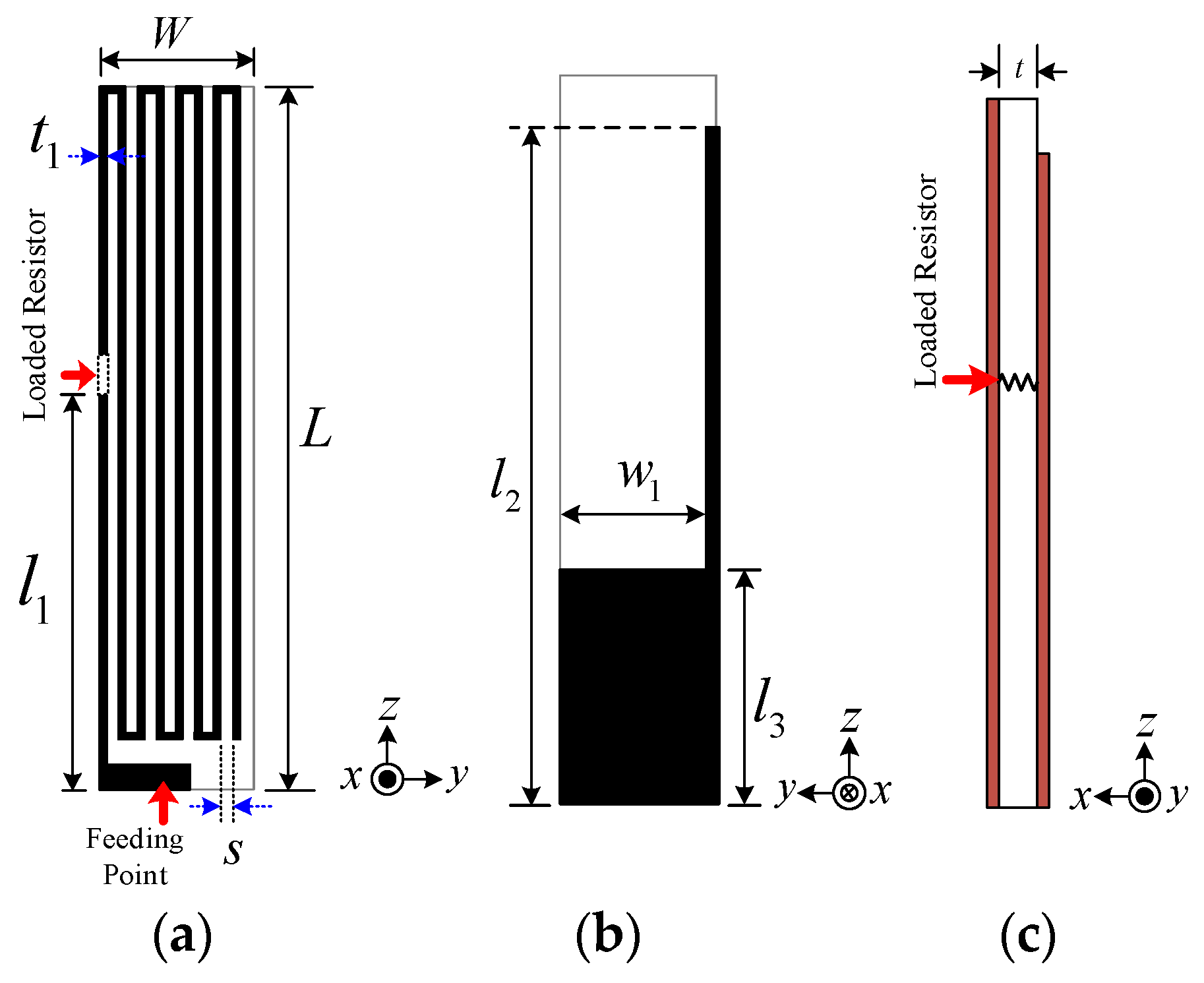


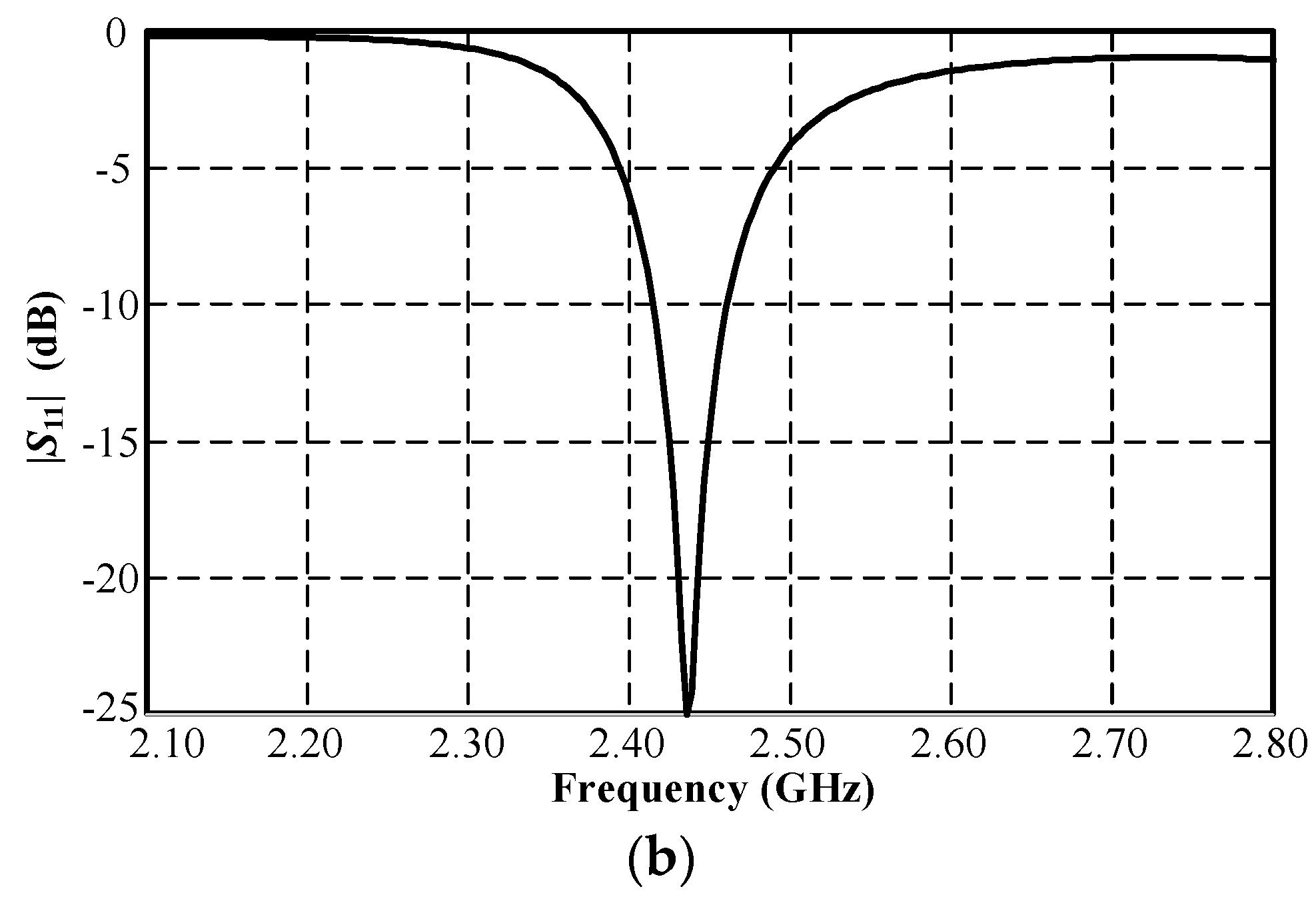
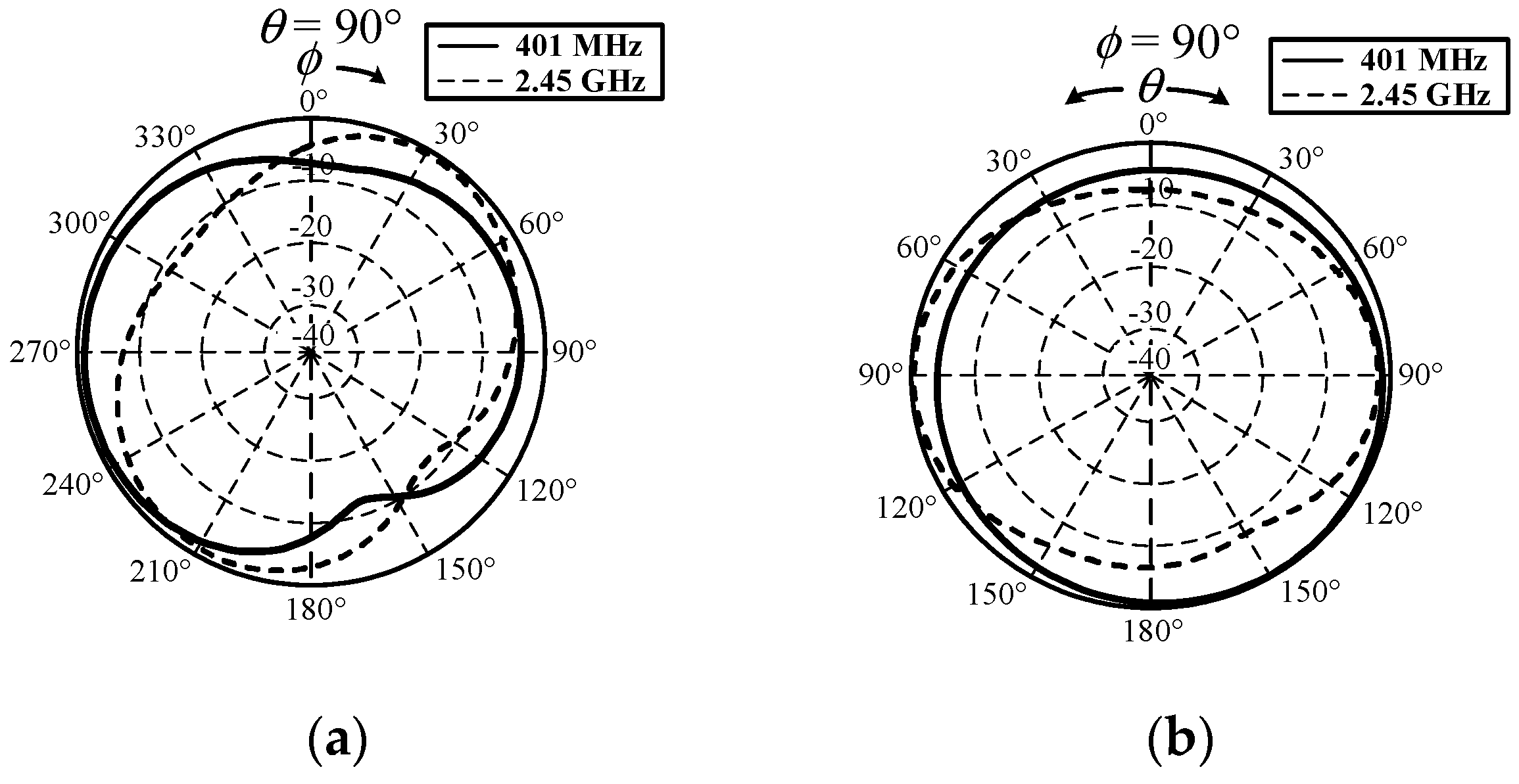
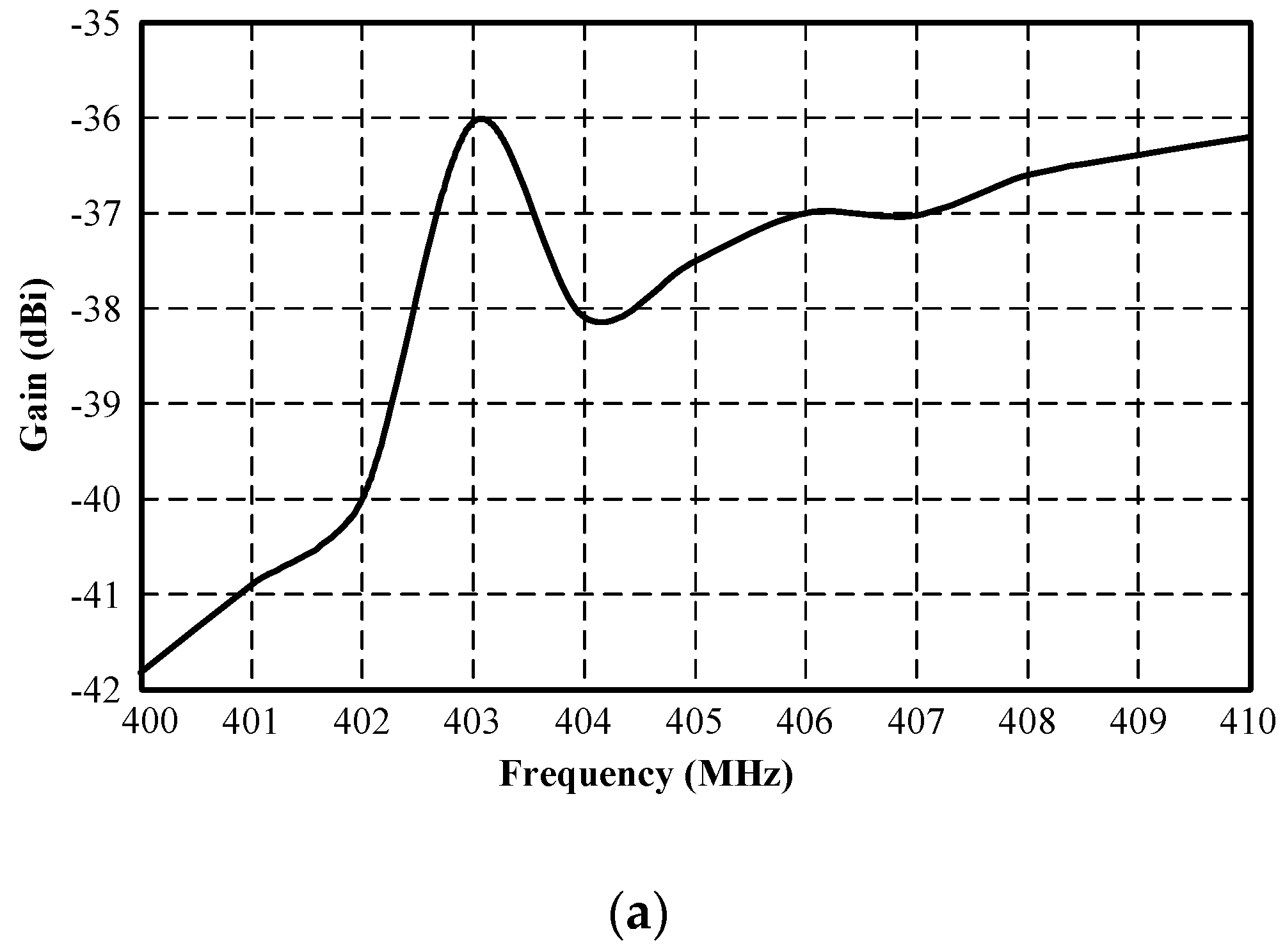
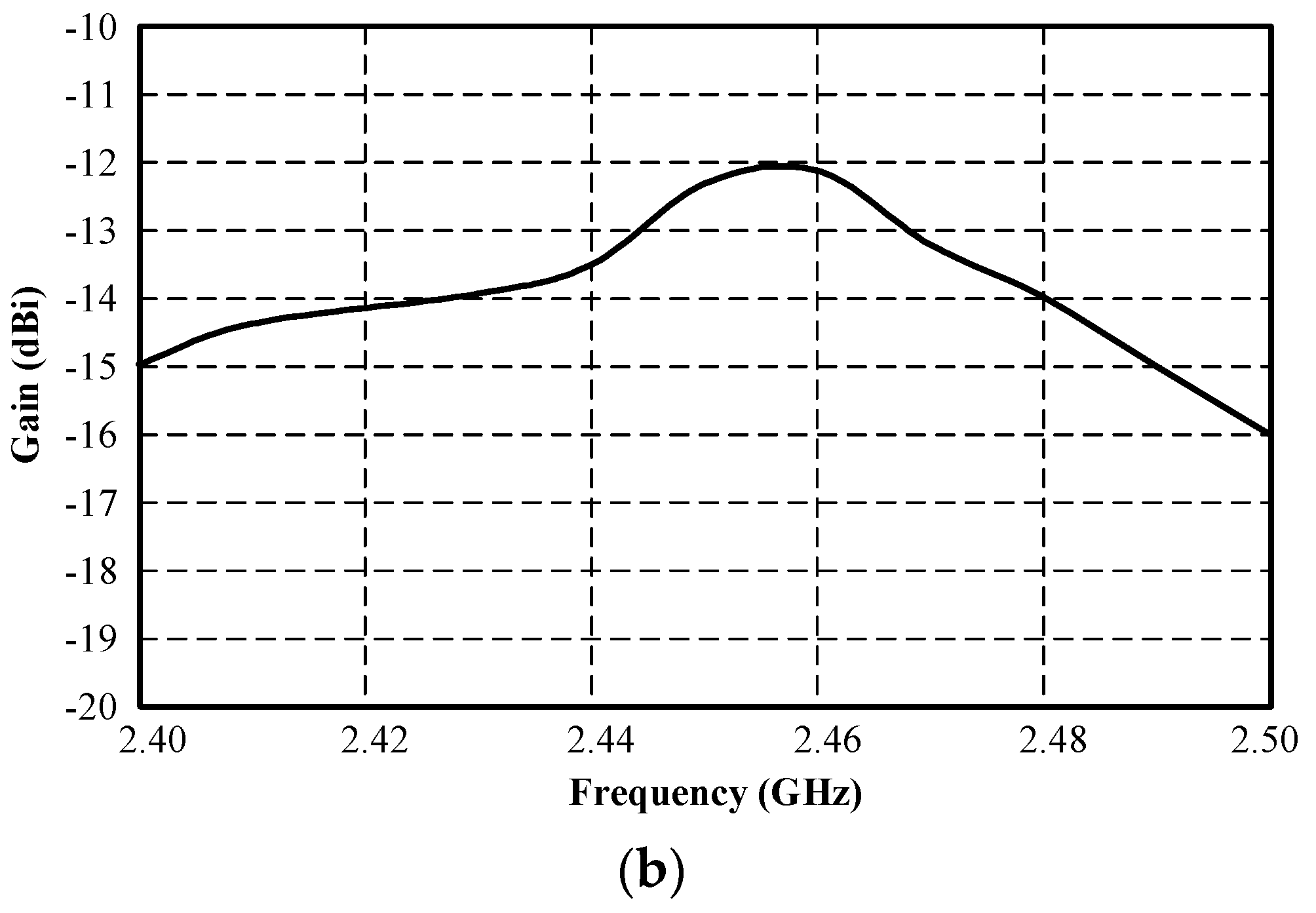
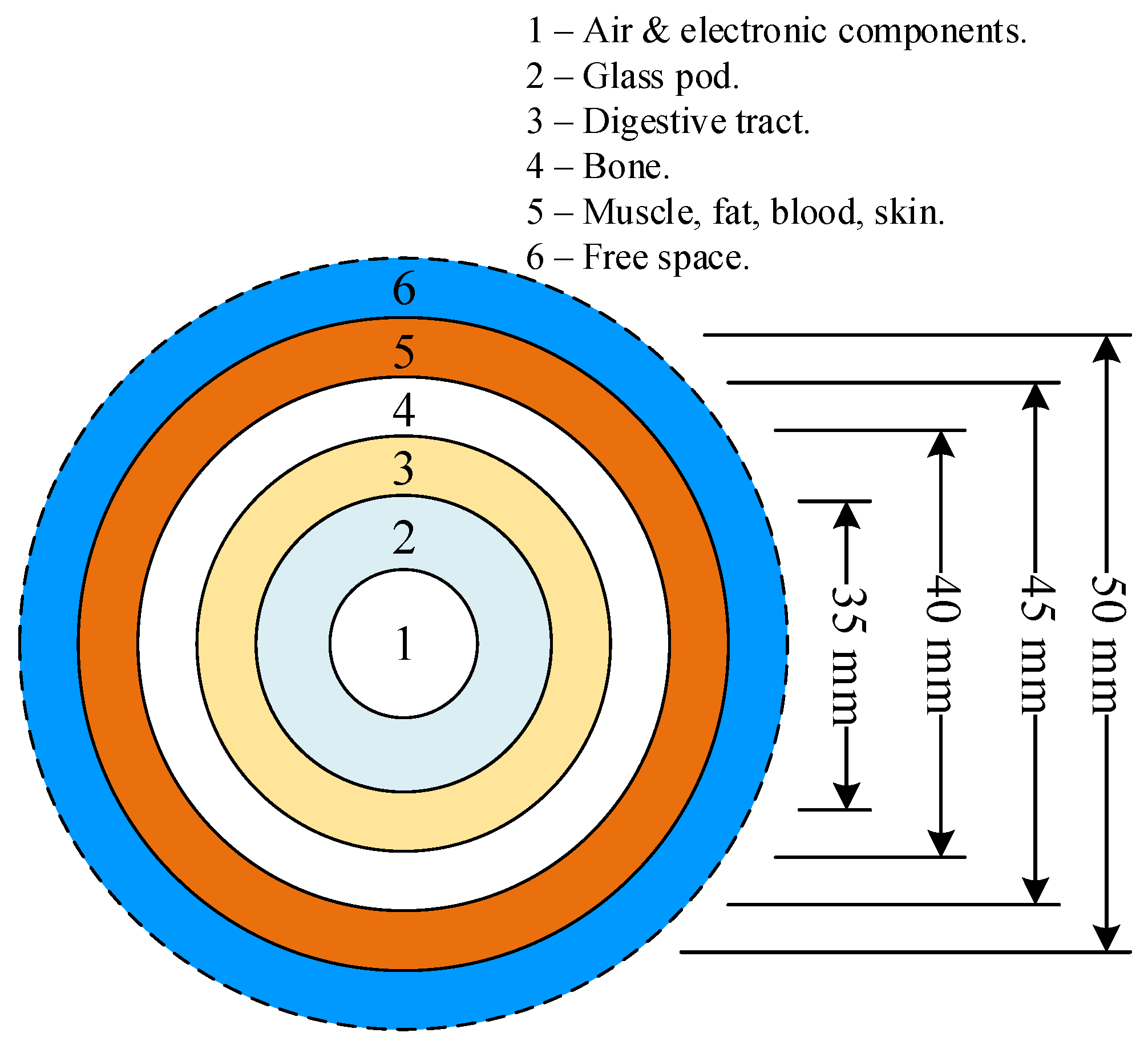
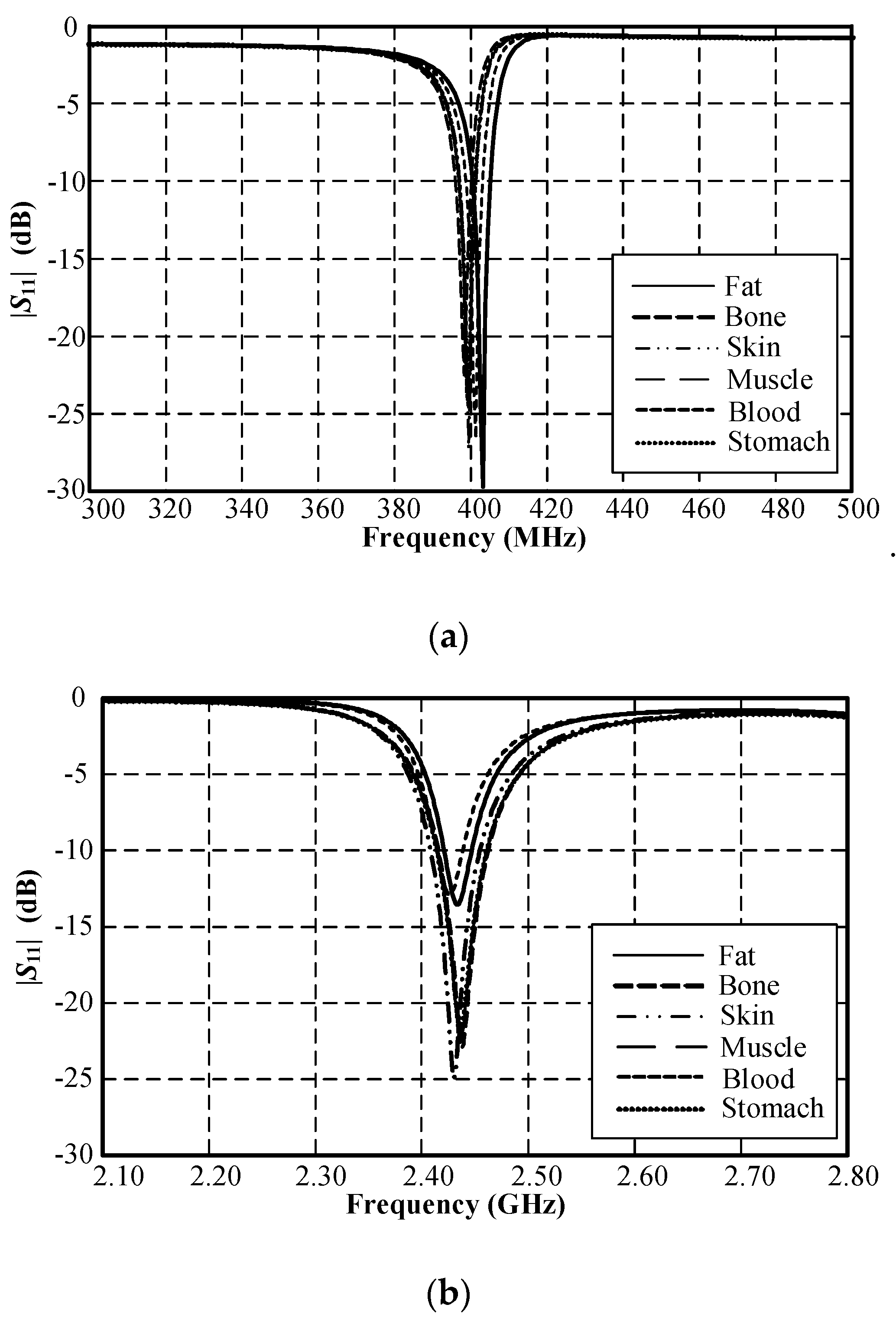
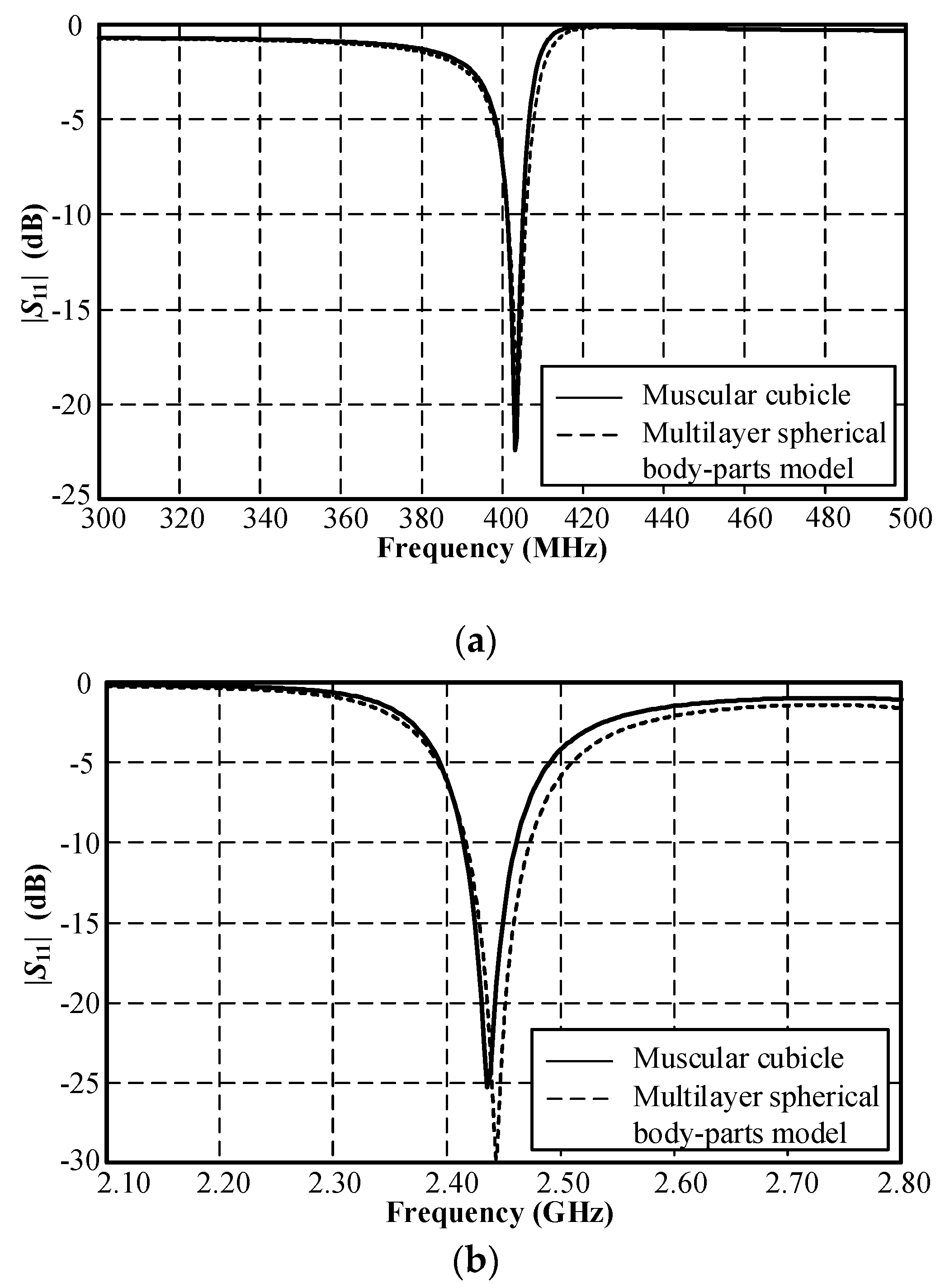
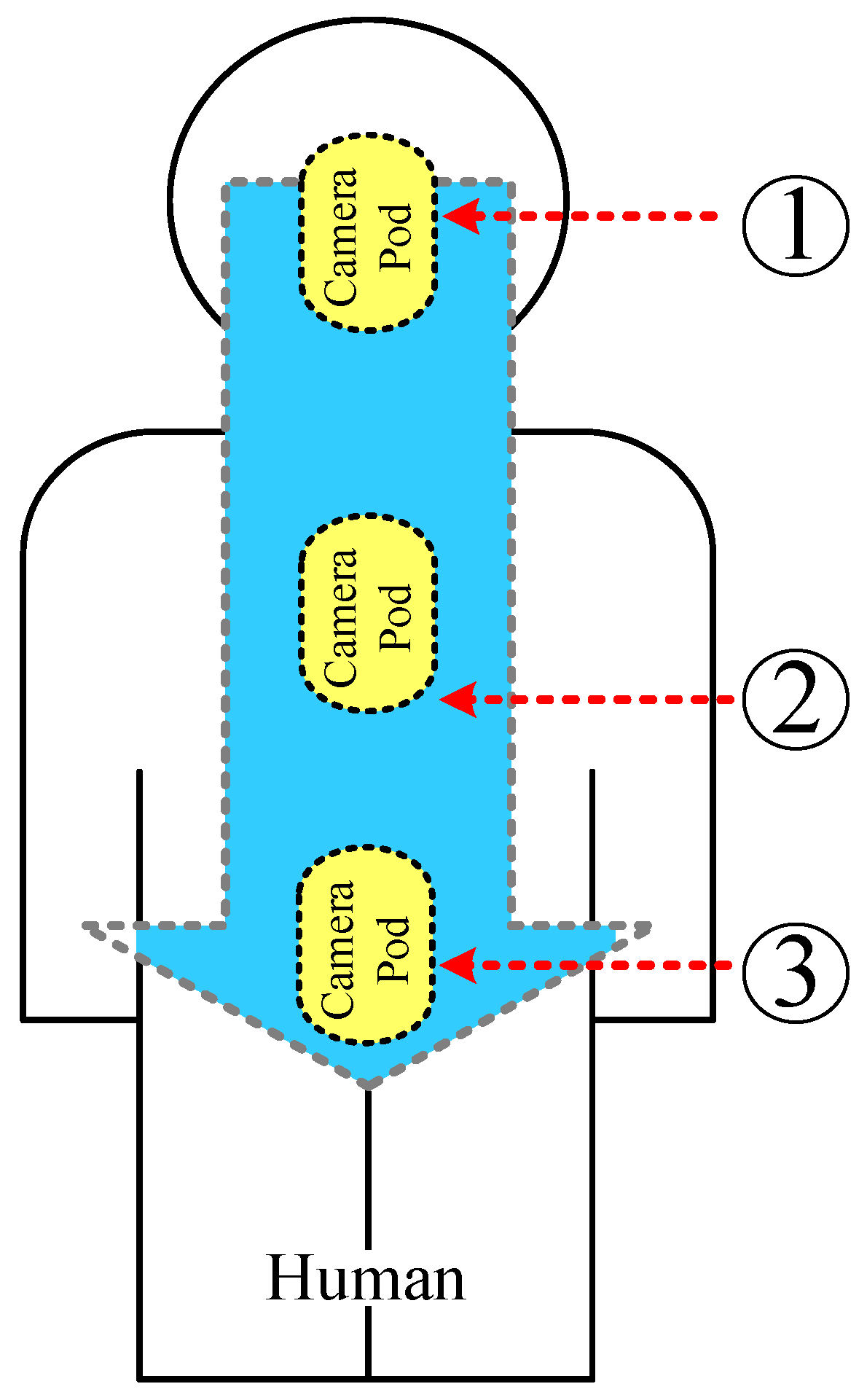
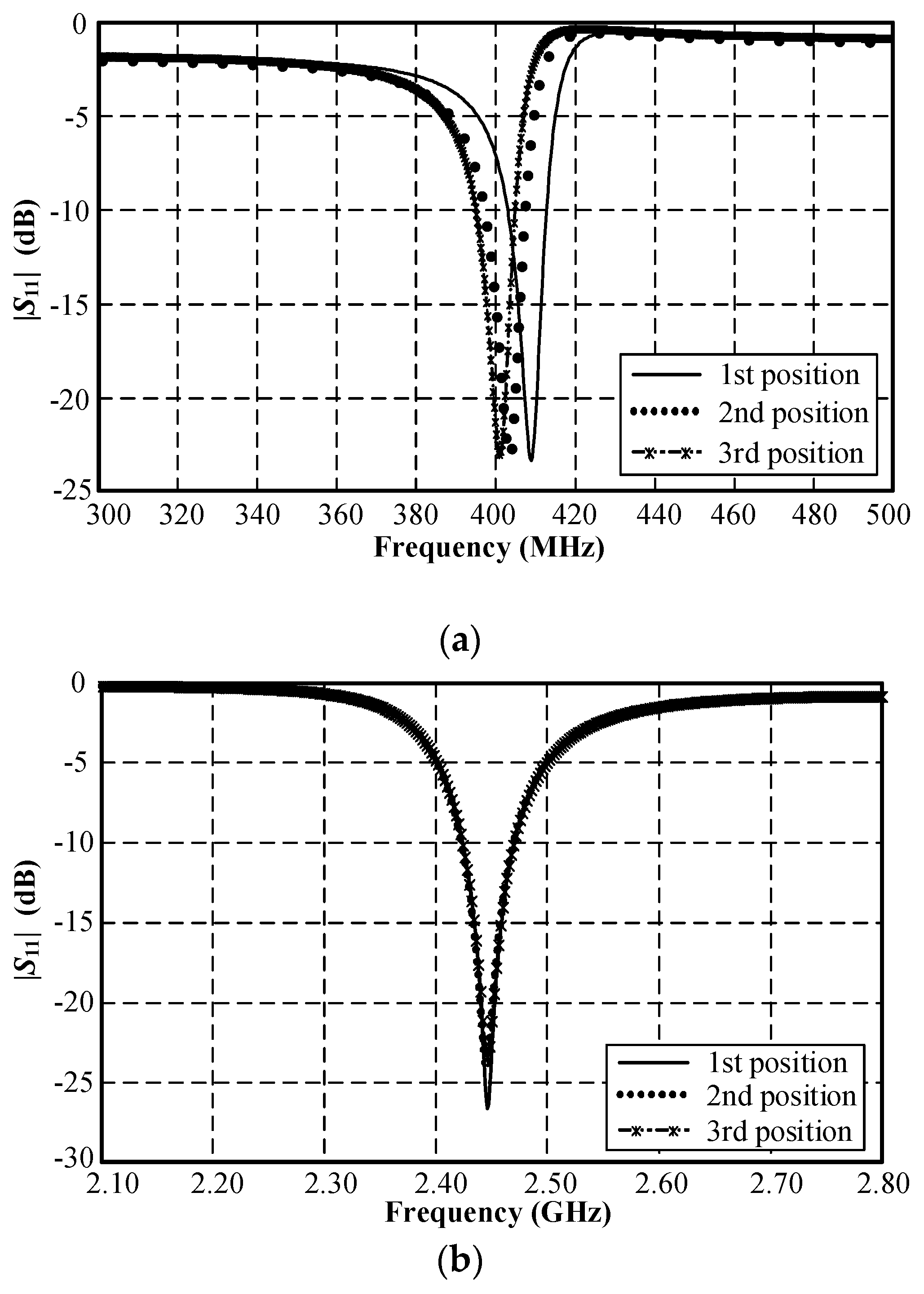

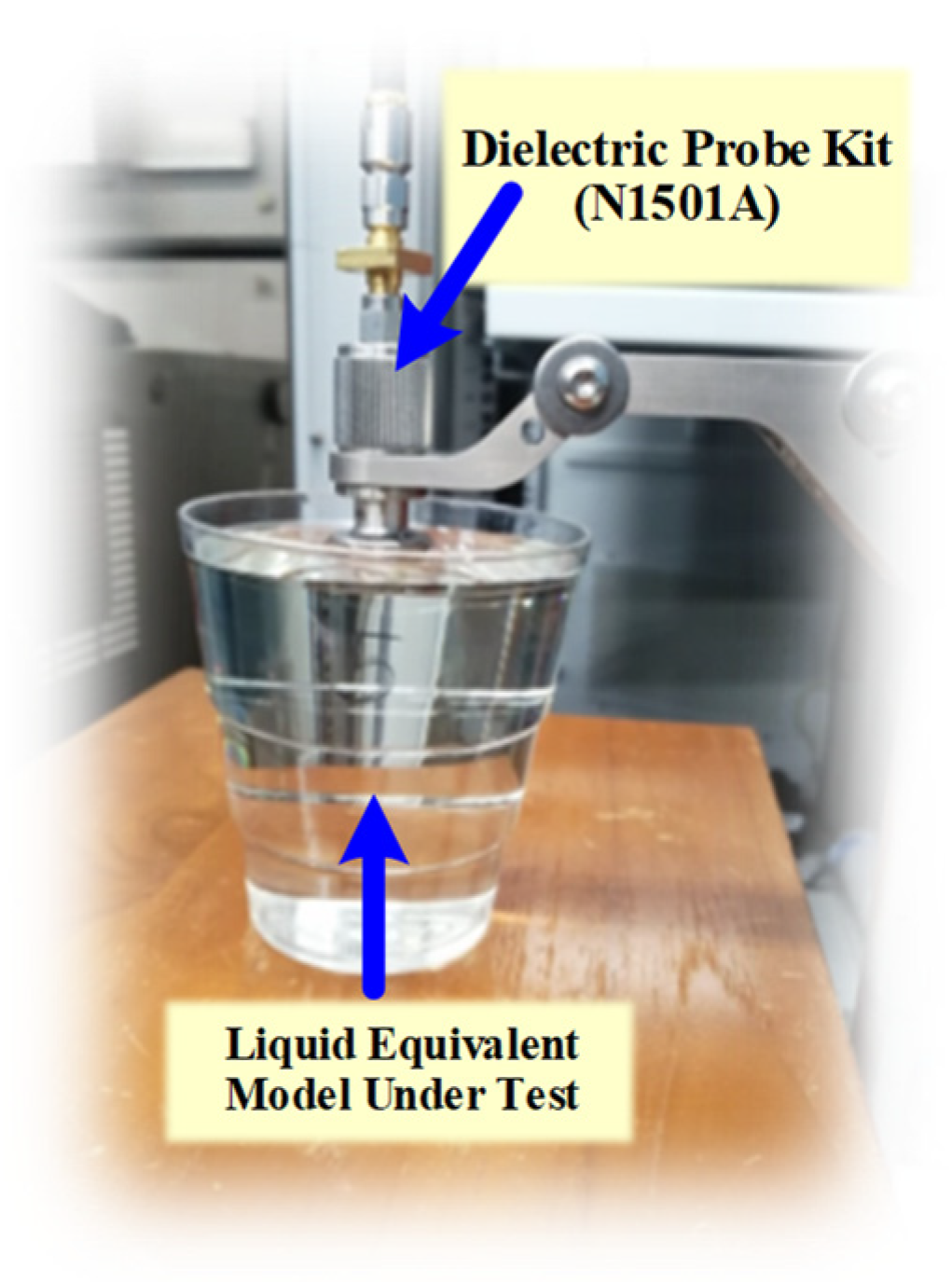




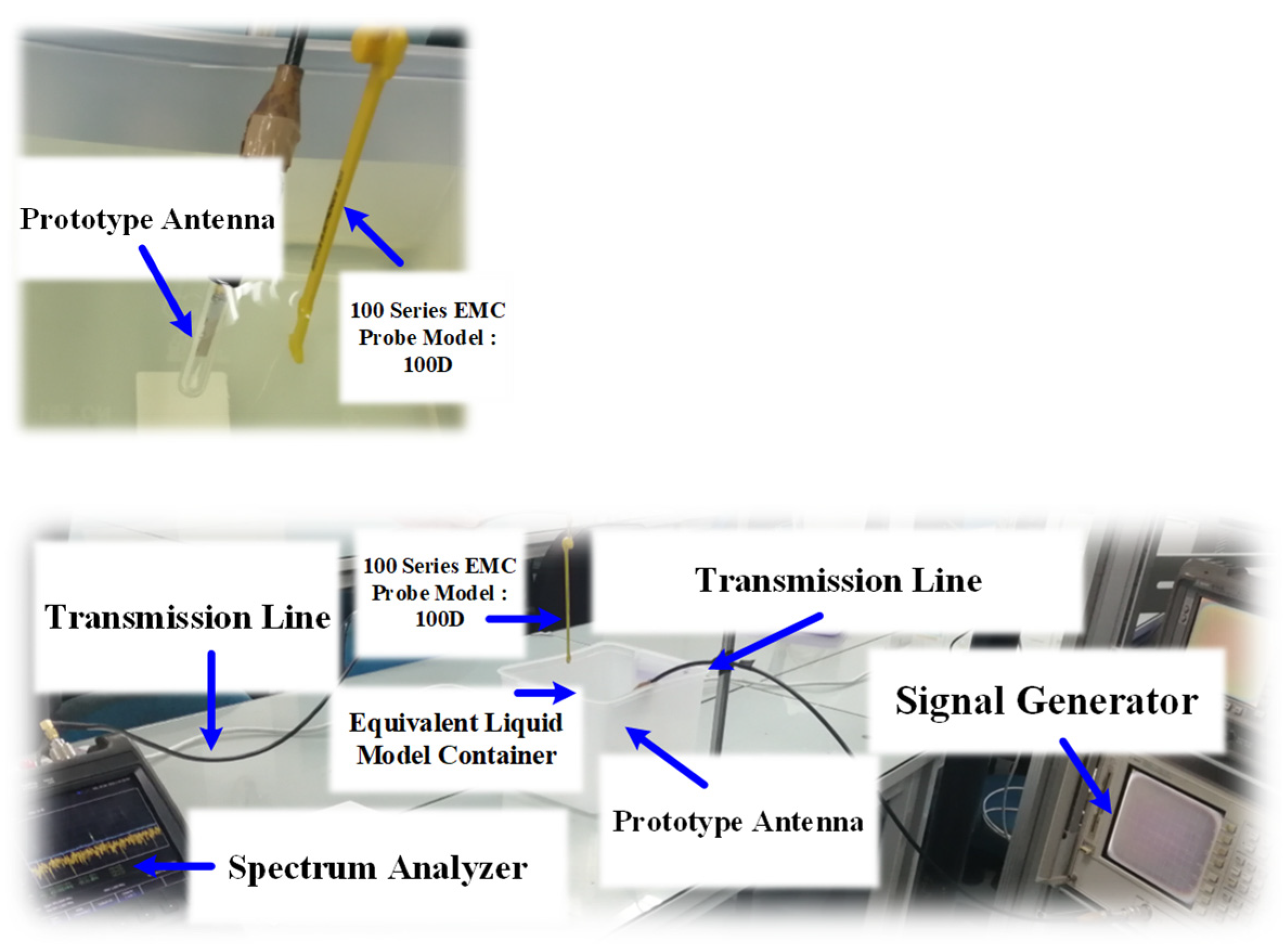
| Antenna | Dimension (mm) | Gain | Frequency Band |
|---|---|---|---|
| [15] | 25 × 34 × 2.5 | −33 dBi at 1.42 GHz and −24 dBi at 2.4 GHz | WMTS and ISM |
| [16] | 15 × 15 × 1.92 | −12.25 dBi at 403 MHz and −12.4 dBi at 2.45 GHz | MICS and ISM |
| [17] | 19 × 30 × 1.6 | −32 dBi at 433 MHz, −11.5 dBi at 1433 MHz and −13 dBi at 2.4 GHz | MICS, WMTS, and ISM |
| Proposed Antenna | 6 × 28 × 1.27 | −38 dBi at 403 MHz and −13 dBi at 2.45 GHz | MICS and ISM |
| Parameter | Description | Initial Physical Size (mm) | GA-Optimized Physical Size (mm) |
|---|---|---|---|
| W | Total width | 6 | 6 |
| L | Total length | 28 | 28 |
| w1 | Width of defected ground plane | 5.5 | 5.0 |
| l1 | Position of loading resistor (2 Ω) | 11 | 11 |
| l2 | Length of defected ground plane | 26 | 25 |
| l3 | Length of flipped L | 9 | 8.5 |
| t | Thickness of substrate | 1.27 | 1.27 |
| t1 | Thickness of meander line | 0.25 | 0.25 |
| s | Distance between meander lines | 0.5 | 0.5 |
| Body Parts | Conductivity (σ): S/m | Dielectric Constant (εr) | ||
|---|---|---|---|---|
| f = 403 MHz | f = 2.45 GHz | f = 403 MHz | f = 2.45 GHz | |
| Stomach | 1.00 | 2.21 | 67.48 | 62.15 |
| Small intestine | 1.90 | 3.17 | 66.14 | 54.42 |
| Blood | 1.34 | 2.54 | 64.18 | 58.26 |
| Bone | 0.23 | 0.80 | 22.44 | 18.56 |
| Muscle | 0.79 | 1.74 | 57.12 | 52.72 |
| Fat | 0.04 | 0.10 | 5.57 | 5.27 |
| Skin | 0.68 | 1.46 | 46.78 | 38.00 |
| Optimization Algorithm | GA | Multi-Objective GA | PSO | Multi-Objective PSO | ||
|---|---|---|---|---|---|---|
| Optimization Goal | Maximum gain | Minimum size | Maximum gain and minimum size | Maximum gain | Minimum size | Maximum gain and minimum size |
| Dimensions (mm) | 15 × 29 | 6 × 28 | 14 × 29 | 14 × 31 | 6 × 28 | 15 × 29.5 |
| Antenna gain | −22 dBi at 403 MHz, −10.5 dBi at 2.45 GHz | −36.04 dBi at 403 MHz, −12.31 dBi at 2.45 GHz | −24 dBi at 403 MHz, −11 dBi at 2.45 GHz | −21 dBi at 403 MHz, −10 dBi at 2.45 GHz | −36.04 dBi at 403 MHz, −12.31 dBi at 2.45 GHz | −23 dBi at 403 MHz, −11.5 dBi at 2.45 GHz |
| Mixture | Syrup | Salt | Water |
|---|---|---|---|
| 1 | 0% | 0% | 100% |
| 2 | 20% | 1% | 79% |
| 3 | 30% | 1% | 69% |
| 4 | 40% | 1% | 59% |
| 5 | 50% | 1% | 49% |
| 6 | 50% | 2% | 48% |
| 7 | 50% | 3% | 47% |
| 8 | 50% | 4% | 46% |
| 9 | 50% | 5% | 45% |
Publisher’s Note: MDPI stays neutral with regard to jurisdictional claims in published maps and institutional affiliations. |
© 2021 by the authors. Licensee MDPI, Basel, Switzerland. This article is an open access article distributed under the terms and conditions of the Creative Commons Attribution (CC BY) license (https://creativecommons.org/licenses/by/4.0/).
Share and Cite
Kawdungta, S.; Boonpoonga, A.; Phongcharoenpanich, C. MICS/ISM Meander-Line Microstrip Antenna Encapsulated in Oblong-Shaped Pod for Gastrointestinal Tract Diagnosis. Sensors 2021, 21, 3897. https://doi.org/10.3390/s21113897
Kawdungta S, Boonpoonga A, Phongcharoenpanich C. MICS/ISM Meander-Line Microstrip Antenna Encapsulated in Oblong-Shaped Pod for Gastrointestinal Tract Diagnosis. Sensors. 2021; 21(11):3897. https://doi.org/10.3390/s21113897
Chicago/Turabian StyleKawdungta, Supakit, Akkarat Boonpoonga, and Chuwong Phongcharoenpanich. 2021. "MICS/ISM Meander-Line Microstrip Antenna Encapsulated in Oblong-Shaped Pod for Gastrointestinal Tract Diagnosis" Sensors 21, no. 11: 3897. https://doi.org/10.3390/s21113897
APA StyleKawdungta, S., Boonpoonga, A., & Phongcharoenpanich, C. (2021). MICS/ISM Meander-Line Microstrip Antenna Encapsulated in Oblong-Shaped Pod for Gastrointestinal Tract Diagnosis. Sensors, 21(11), 3897. https://doi.org/10.3390/s21113897






